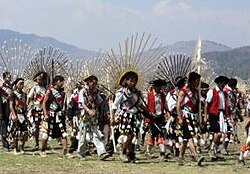This article has multiple issues. Please help improve it or discuss these issues on the talk page . (Learn how and when to remove these messages)
|
 Glory Day celebration of the Poumai Naga | |
| Total population | |
|---|---|
| 187,180[ citation needed ] (2011 census) | |
| Regions with significant populations | |
| Manipur | 179,189 [1] |
| Nagaland | 6000-10,000 [2] |
| Languages | |
| Poula | |
| Religion | |
| Predominantly Christianity [ citation needed ] | |
| Related ethnic groups | |
| Mao Naga Chakhesang | |
| Part of a series on |
| Naga people |
|---|
| Ethnic groups |
| Languages |
The Poumai people, also known as the Poumai Naga, are a Tibeto-Burman ethnic group that inhabit the Northeast Indian states of Manipur and Nagaland. The Poumai predominantly live in the Senapati District of Manipur, though there are villages in Nagaland state and one in Ukhrul district. The Poumai mainly live in 100 villages that have been broadly divided into three blocks: Paomata, Lepaona and Chilivai. The Poumai speak their own language, Poula, and are generally Christian.
